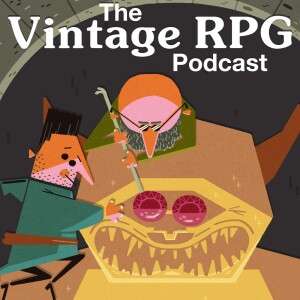Hambone breaks it down (00:18).
The guys start off with Ghost Fightin’ Treasure Hunters, a co-op board game about finding treasure in a haunted house (01:33). Stu explains how it reminds him of another co-op game, Flash Point, about fighting fires (03:03). Hambone talks a bit about the games two expansion (04:41).
Hambone introduces the main course of our feast, D&D module I6 - Ravenloft (06:23). He declares it the best stand-alone module for D&D, though Stu disagrees (06:42).
An unexpected hypothetical interlude about the 1979 cult classic film, The Warriors (08:38).
Back on track. Hambone explains how much he loves the idea of a dungeon crawl through Dracula’s castle (09:55) and goes ga-ga over the maps (10:28). They discuss how experimental the module was for the time (12:00) and what kind of music Strahd is probably into (13:49).
Stu breaks down how important Strahd is in terms of villain design (14:53). Hambone talks about how difficult it is to run Strahd as a master tactician (17:00). Curse of Strahd for 5E comes up (19:20). Stu offers his final thoughts on the module (21:00) and touches on House on Gryphon Hill, the sequel to Ravenloft (22:00). Castlevania: Simon’s Quest comes up (24:10) and Bram Stoker’s Dracula, too (25:34).
Hambone briefly gets excited about Mixtape Massacre (28:00) and the guys say their farewells.
*
Clarification: Let’s talk dates. Ravenloft came out in 1983. House on Gryphon Hill came out in 1986. Castlevania came out in Japan in 1986 and North America in ‘87 while Castlevania II: Simon’s Quest came out in Japan in ‘87 and North America in ‘88. Judging from the art on the cover of Simon’s Quest, it is pretty clear that Ravenloft was at least on the radar of the videogame developers.
More Episodes
 2023-09-11
2023-09-11
 2023-09-04
2023-09-04
 2023-08-28
2023-08-28
 2023-08-21
2023-08-21
 2023-08-14
2023-08-14
 2023-08-07
2023-08-07
 2023-07-31
2023-07-31
 2023-07-24
2023-07-24
 2023-07-17
2023-07-17
 2023-07-10
2023-07-10
 2023-07-03
2023-07-03
 2023-06-26
2023-06-26
 2023-06-19
2023-06-19
 2023-06-12
2023-06-12
 2023-06-05
2023-06-05
 2023-05-29
2023-05-29
 2023-05-22
2023-05-22
 2023-05-15
2023-05-15
 2023-05-08
2023-05-08
 2023-05-01
2023-05-01
Create your
podcast in
minutes
- Full-featured podcast site
- Unlimited storage and bandwidth
- Comprehensive podcast stats
- Distribute to Apple Podcasts, Spotify, and more
- Make money with your podcast
It is Free
- Privacy Policy
- Cookie Policy
- Terms of Use
- Consent Preferences
- Copyright © 2015-2024 Podbean.com






